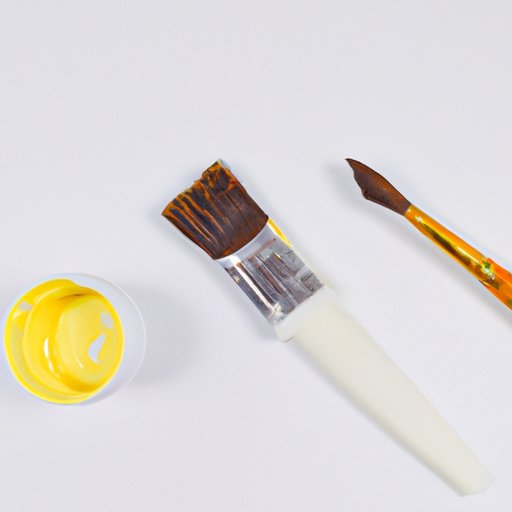
I. Introduction
Keeping your acrylic paint brushes clean is crucial for their longevity and quality. Dirty brushes can affect the color, texture, and consistency of your paintings. In this article, we will guide you through the steps necessary to properly clean acrylic paint brushes and offer expert tips and DIY hacks to make the process easier.
II. Step-by-Step Guide to Cleaning Acrylic Paint Brushes
Before starting the cleaning process, gather the necessary materials such as soap, water, solvent, and paper towels. Begin by removing any excess paint from the brush bristles by wiping them against a paper towel or rag.
Next, wash the bristles with warm water and a gentle soap. Lather the soap in your hands or on a brush cleaning mat and gently massage the bristles. Rinse the brush until the water runs clear.
If the paint is stubborn, you can use a solvent such as turpentine or rubbing alcohol. Dip the brush into the solvent and let it sit for a few minutes. Rinse the brush with water and soap afterward.
It is important to handle solvents with caution and use them in well-ventilated areas. Wear gloves to protect your skin.
III. Best Practices for Cleaning and Maintaining Acrylic Paint Brushes
To maintain the quality of your brushes, handle them with care. Avoid using them on rough surfaces and do not leave them in water for extended periods of time.
After each use, clean your brushes thoroughly to prevent the paint from drying and hardening on the bristles.
When storing your brushes, place them upright in a brush holder or lay them flat with the bristles faced upwards. This will prevent the bristles from becoming misshapen.
IV. Expert Tips for Cleaning Acrylic Paint Brushes
We spoke with a professional artist and art supply store owner for their expert tips on cleaning and caring for acrylic paint brushes.
Firstly, they suggest investing in a brush cleaner solution. These solutions are specifically designed to dissolve acrylic paint and restore the flexibility of the bristles.
They also recommend soaking brushes in liquid fabric softener to soften the bristles and remove any remaining paint. Afterwards, rinse the brushes with water and soap.
Lastly, they advise being aware of the differences between synthetic and natural bristle brushes. Synthetic brushes tend to be more durable and can handle rougher surfaces. On the other hand, natural bristle brushes are softer and work best with smoother surfaces.
V. DIY Hacks for Cleaning Acrylic Paint Brushes
If you’re in a pinch and don’t have traditional cleaning materials on hand, there are some unconventional methods that can be used.
Vinegar, for example, can be used to break down the paint. Soak the brush in vinegar for several hours, then rinse with soap and water. Another alternative is using hair conditioner. This will make the bristles softer and easier to clean.
However, be aware that there could be potential downsides to these methods. Vinegar can be harsh on the bristles and using hair conditioner may leave a residue that can affect the paint.
VI. Product Reviews for Acrylic Brush Cleaning Products
There are many cleaning products specifically designed for acrylic paint brushes. We evaluated some of the most popular and effective options.
The Masters Brush Cleaner and Preserver is a long-time favorite among artists. It is a soap-based cleaner that can easily remove stains and restore the shape of the bristles.
Another popular product is Winsor & Newton’s Brush Cleaner and Restorer. It is designed to dissolve dried acrylic paint and nourish the bristles.
Both products are effective, but more expensive than traditional soap and water.
VII. Frequently Asked Questions About Cleaning Acrylic Paint Brushes
Here are some commonly asked questions about cleaning acrylic paint brushes and maintaining their quality.
How often should I clean my brushes?
It is recommended to clean your brushes after each use to prevent the paint from drying and hardening on the bristles.
What tools do I need to clean acrylic paint brushes?
The basic tools you need are soap, water, and paper towels. However, solvents and brush cleaning solutions can also be used.
How do I know if my brush is damaged?
If your brush has stray bristles or is misshapen, it may be damaged. It is best to replace damaged brushes to maintain the quality of your paintings.
VIII. Conclusion
Cleaning your acrylic paint brushes is an important step in maintaining their quality and longevity. Remember to remove excess paint, wash with soap and water, and handle solvents safely. It is also best to store your brushes properly and handle them with care.
By following these steps and using expert tips and DIY hacks, you can easily clean your brushes and ensure that they last for many painting sessions to come.




